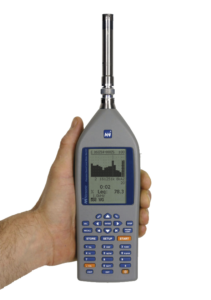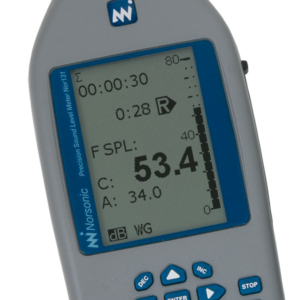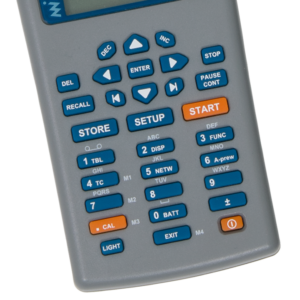Sound Level Meters Nor131/Nor132




Sound Level Meters Nor131 and Nor132 are designed and manufactured to the latest sound level meter standards and comprises two products.
The Nor131 is a Class 1 (precision) instrument whilst the Nor132 is designed in accordance with the less accurate Class 2 requirements. Both meters offer the same features with exception of the detachable preamplifier which is only available on the Nor131 version.
The Nor130 series of SLM fulfil the following Sound Level Meter and 1/1&1/3 octave filter standards: IEC 60651, IEC 60804, IEC 61672, IEC 61260, ANSI S1.4, ANSI S1.11, ANSI S1.43, DIN45657.
English, French and German language support.
- Noise hazards in the workplace
- Prescription of hearing protection
- Environmental noise investigations
- Product noise testing
- General purpose sound level meter
- Reverberation measurement
- Speech intelligibility
- Single measurement range
- Extremely simple operation
- Parallel LAeq and LCpeak
- Complies to IEC and ANSI standard
- Real time 1/1 octave and 1/3 octave
- Statistical analysis
- Level versus time
- Speech Transmission Index (STIPA) calculation
- Reverberation time calculation
- Large back-lit display
- Large internal memory
- USB interface
- Multi language support
The Nor131 and Nor132 sound level meters may be extended with a selection of optional features that may be ordered and installed at any time.
The Nor130 series of SLM’s may be extended with digital real-time 1/1-octave filters. This feature is available through the installation of option 1, and covers 12 frequency bands in the range from 8Hz to 16kHz.
Within each band, the instrument will measure the SPL, Leq, LMax, LMin and LE functions. Additionally, if the Option 2 Statistical analysis is installed, 8 different LN-percentiles are calculated within each 1/1-octave band.
- A-preweighting feature available on display results.
- All filters fulfill the IEC 61260 class 1 digital IIR base 10 requirements.
- 120 dB “one-range” even in the filter bands.
- Results are displayed both graphically and numerically.
- Calculate 7 fixed LN values (L1%, L5%, L10%, L50%, L90%, L95% and L99%).
- Parallel calculation of 1 editable LN value selectable within the range 0.1 – 99.9 %.
- Statistical calculations based on 0.2 dB class widths covering the entire 130 dB range.
- Parallel statistical calculation on both A- and C-/Z-weighted networks.
- If real-time filters are installed (option 1 or 3), statistical calculations are available for the individual filter bands as well.
Option 4 adds statistical distribution to the Nor31/Nor132 functionality. There are eight percentiles shown, out of which one is user selectable. The class width is 0.2 dB over the entire 130 dB range.
The statistical distribution calculations employs the F time constant and applies to the spectral weighting networks (A and C or Z) as well as all the individual 1/1 and 1/3-octave filter bands (if applicable). The back-erase feature, which deletes up to the ten most recent seconds of acquired global data prior to a pause upon resuming, updates the statistics buffers as well to maintain consistency.
 Nor131 and Nor132 Option 2 – The LN percentage table contains 7 fixed and one user-defined percentile
Nor131 and Nor132 Option 2 – The LN percentage table contains 7 fixed and one user-defined percentile
- Simultaneous measurement of Global results and Profile results based on a level versus time values at preset intervals
- Selection of preset intervals within the 1 second to 199 hours interval range
- Automatic level versus time storage of LAeq, LAmax and LCpeak (or LZpeak)
- Level versus time measurement continues during a paused Global measurement
- Markers identify any pause, stop or continue of the measurement
- To view or report the result simply transer the measurement result to PC using NorXfer and NorReview. Measurement results may also be automatically converted to Excel using NorXfer
The Nor130 series of SLMs may be extended with digital real-time 1/3-octave filters. This feature is available through the installation of option 4.
Within each band, the instrument will measure the SPL, Leq, LMax, LMin and LE functions. Additionally, if the Option 2 Statistical analysis is installed, 8 different LN-percentiles are calculated within each 1/3-octave band.
- Parallel 1/3-octave real-time filters covering the 6.3 – 20000 Hz frequency range.
- All filters fulfill the IEC 61260 class 1 digital IIR base 10 requirements.
- A-preweighting feature available on display results.
- 120 dB “one-range” even in the filter bands.
- Results are displayed both graphically and numerically.
Reverberation time measurement mode is now available on the sound level meter Nor131 and Nor132.
- Reverberation time based on impulse excitation
- Calculates both T20 and T30
- Covers the 63 – 8000 Hz frequency bands for the 1/1-octave filters
- Covers the 50 – 10000 Hz frequency bands for the 1/3-octave filter
Option 5 requires that option 1: 1/1-octave bands is installed!
- Calculates the STIPA speech transmission index
- Fulfils the requirements of the latest IEC 60268-16 ed. 5 Standard for STIPA
- Includes signal (.vaw) for use through separate public address
- Loudspeaker system or portable CD-player can be used for playback of signal
- Background noise correction
It is now possible to use the Nor131 and Nor132 meters for analysing the Speech Transmission quality in public areas using the STIPA method. The method can be used to compare the speech transmission quality at various positions and under various conditions within the same listening space. The calculation follows the latest revision of the standard (2011-6).
A measurement in one listening position takes about 13 sec. Unlike many other STIPA measurement systems, the implementation with the Nor131/132 can also correct the results for the background noise. In addition all calculated indexes are displayed, not only the single STIPA value. This feature is valuable for engineers optimizing the room acoustics in public spaces or other areas where the speech quality is important.
Option 6 requires that option 1: 1/1-octave bands is installed!







